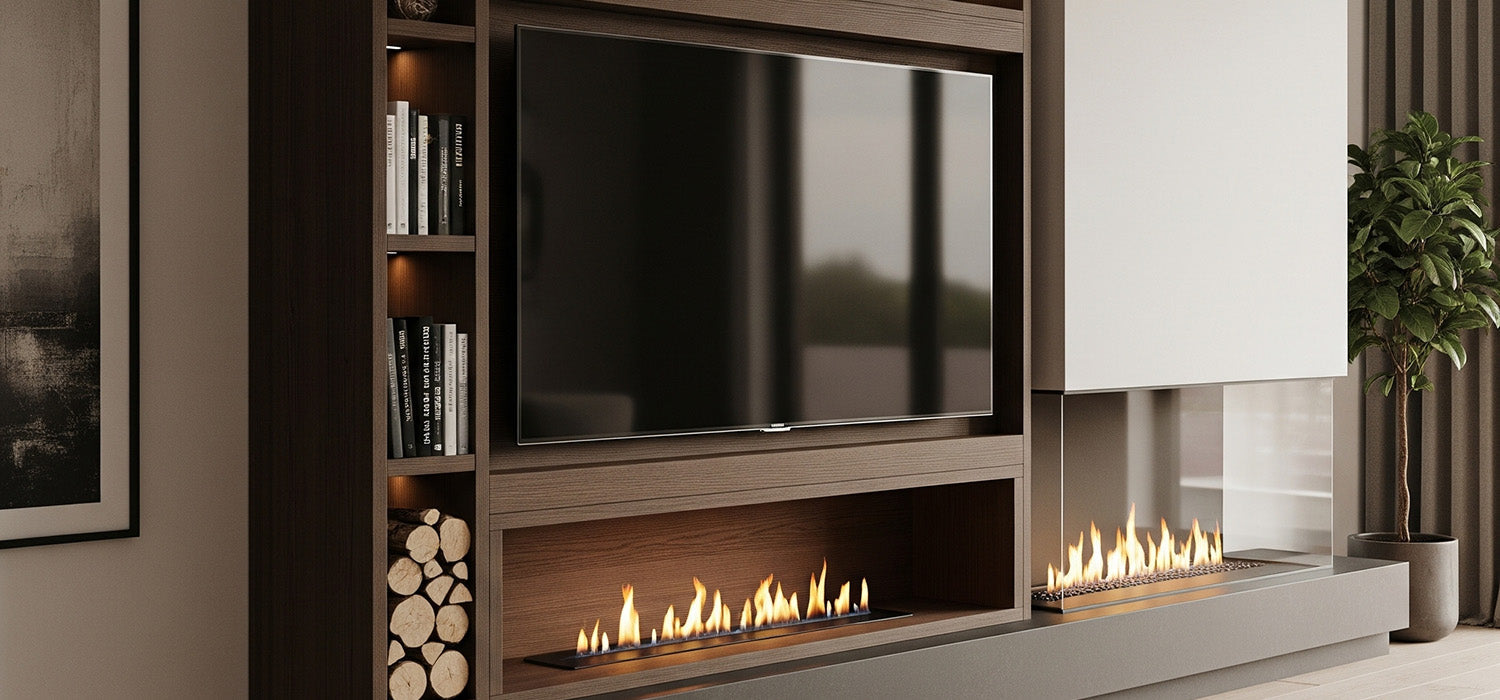
Media Wall Box: The Secret to a Sleek, Cable-Free Setup
Dreaming of a sleek Media Wall Fire setup but your telly’s sticking out like a sore thumb? The short answer: you need a media wall box. It hides cables, fits your gear flush, and looks amazing. Keep reading for sizing tips, soundbar slots, fire safety, and those all-important finishing touches!
What Exactly Is a Media Wall Box?
Think of a media wall box as the backstage crew of a performance—it’s not in the spotlight, but nothing runs without it.
It’s essentially a hollowed-out section built into your media wall. Tucked behind the plasterboard or MDF framework, it houses your tech—TVs, soundbars, consoles, and cables. Everything gets a place.
If you've ever seen a flat-screen floating beautifully with no visible wires or boxes, chances are there's a recessed box working its magic behind the scenes.
Why Bother with One?
It Keeps Things Looking Tidy
Messy wires ruin everything. A wall box lets you feed power cables, HDMI leads, and speaker wires through cleanly, with no tangles or trip hazards.
Let’s face it—nobody wants to see a PlayStation hanging out of a shelving unit or wires snaking across the skirting.
It Saves You Space
In smaller homes, where every inch matters, a recessed box keeps your tech flush with the wall. No bulky units sticking out. No need for a big TV stand.
That means you can open up the floor, reposition furniture more freely, and give your space a more open feel.
It Makes Everything Safer
With boxes mounted securely in the wall, there’s less chance of someone knocking over the telly or pulling a cable by mistake.
If you’re including a media wall fire (and many are), you’ll also want to keep flammable cables out of harm’s way. Fire-rated boards and proper spacing are key.
Different Types of Media Wall Boxes
Recessed TV Box
This is the big one. Designed to fit your TV snugly into the wall, it gives that ‘built-in’ appearance we all love.
It usually sits centre stage and needs enough depth to accommodate the screen and bracket—plus room to breathe.
Soundbar Slot
Often located just beneath the telly, this niche is narrower and shallower but no less important.
It keeps your audio kit aligned with your viewing setup for great sound and a tidy look. Just make sure it’s tall enough—most soundbars need at least 10 to 15 cm clearance.
AV and Console Cavities
Gaming setup? Sky Q? Streaming boxes?
These get their own shelf or niche—usually tucked to one side or below the main display. Keep them ventilated and easily accessible. You don’t want to be prying off plasterboard just to reset the Wi-Fi.
Fireplace Recess
Planning to add a built-in electric or bioethanol fire? You’ll need a dedicated recess with the right clearances and fire-rated backing.
These should be planned early—they’re not easy to retrofit once the wall’s up.
Materials That Make It Work
MDF for Structure and Style
Most media walls use MDF for the framework and finish. It’s strong, smooth, and ideal for painting. Recess boxes can be built from the same material for a seamless look.
Plasterboard for Lightweight Builds
If you’re keeping things simple, plasterboard does the trick. It’s quick to cut and easy to mount. Just be sure it’s supported properly behind.
Fire-Rated Boards for Hot Spots
Behind electric fires and other heat-producing gear, use fire-rated plasterboard. It’s a non-negotiable if you want to keep your home safe and compliant.
Let’s Talk Sizing
TV Dimensions Matter
For a 65-inch TV, you’ll typically want a recess about 144 cm wide and 83 cm high, with at least 12–15 cm depth. Always leave a couple of centimetres extra for airflow and cable bends.
Don’t Forget Clearance
Make sure devices don’t fit too tight. You’ll regret it when you’re trying to swap a HDMI lead or pull the telly out for maintenance.
As a rule of thumb, leave 2–3 cm margin on each side. It’s a small thing, but it makes a big difference.
Installation Tips from the Trade
Plan Before You Board
Mark out where the boxes go before plastering or panelling anything. It’s messy and awkward to change later.
Add a Backboard
Use a strong backboard—MDF or ply—so your brackets, shelves, or mounts have something solid to grip. Studs alone don’t always cut it.
Pre-Drill for Cables
Drill in your cable routes early. It’s far easier than fishing them through tiny holes later. Add brush plates or cable grommets to keep it all tidy.
Think Ventilation
Don’t box your devices in completely. AV gear and fires get warm. Allow for natural airflow—or install mesh panels or mini vents to avoid overheating.
Real Homes, Real Setups
We’ve seen homeowners squeeze 75-inch TVs into tight spots, only to realise the HDMI plug at the back doesn’t fit. Others forget to leave space for the soundbar remote sensor and wonder why it doesn’t work.
Or that family who thought they could stash the Sky box behind the TV—only to discover the remote couldn’t talk to it anymore. Oops.
These are the kinds of mistakes a good recess box helps you avoid.
Final Touches: Styling the Recess
Once your box is in, it’s all about finishes. You can paint the MDF the same colour as your wall for that seamless look.
Want drama? Add LED strip lighting around the TV or fire. Or install a floating shelf inside your AV niche with a soft spotlight above it. Done right, it’ll look like something straight from a show home.
Wrapping Up: Why a Media Wall Box Matters
The media wall box might be hidden, but it plays a starring role. It’s what lets you create a truly modern, clutter-free, and high-impact setup.
Whether you’re building it yourself or bringing in a pro, don’t skip the box. Plan it properly, build it smartly, and your living room will thank you for years to come.
Behind every impressive screen and glowing fire, there’s a smart little box making it all work.
Other content we think you'll love
- Media Wall Accessories: Style, Function and Wow Factor
- Media Wall Accessories Ideas: How to Style Your Space with Flair
- Media Wall Acoustic Panels: Enhance Sound & Style at Home
- Creative Media Wall Alcove Ideas for Stylish, Functional Homes
- Media Wall Alcove Ideas: Stylish Designs That Maximise Space
- Media Wall Access Panels: Why You Shouldn’t Skip This Clever Feature
- Media Wall Back Panels: Stylish Ideas to Elevate Your Space
- Media Wall Boards: The Complete Guide to Strong, Safe Builds
- Built-In Media Walls: Transform Your Living Room with Style and Function

